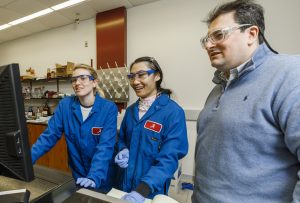
Marco Bonizzoni is an associate professor and director of graduate recruiting in The University of Alabama’s Department of Chemistry and Biochemistry. He is also an Arts & Sciences Distinguished Teaching Fellow.
Bonizzoni leads a group of graduate students that focuses on the design and characterization of supramolecular systems, which are complex chemical systems that extend beyond a single molecule. Specifically, the group is interested in systems held together by non-covalent interactions in water-based solutions, for analytical, environmental and biomedical applications.
“Intermolecular interactions are the basis of life. Proteins, DNA and our very living cells are held together through careful use of such interactions,” Bonizzoni said. “Their use in man-made systems is nowhere near as sophisticated as in living organisms, but it has the same potential. These techniques also sometimes naturally lend themselves to applications relevant to human well-being and development, which make them interesting and worthwhile and have the potential for significant impact on everyday applications.”
Bonizzoni’s group is working with five higher education institutions within the Alabama-Mississippi area. They are collaborating on a project funded by the National Science Foundation to develop polymer-based chemical sensors to detect environmental pollutants in the Gulf of Mexico and its tributaries. Research such as this brings a molecular perspective to the Alabama Water Institute, connecting macroscopic geological and geochemical events and their effects at the nanoscale level.
“These collaborative projects fit well within the framework of the Innovations at the Nexus of Food, Energy and Water thrust at the NSF,” said Bonizzoni. “We are particularly tasked with using pattern-based recognition methods to recognize and measure classes of pollutants in water. Think of them as the ‘fingerprinting’ of chemicals.”
Bonizzoni said there is still a substantial divide between chemical sensing methods proven in lab conditions and their deployment as rugged devices in challenging environments, such as unattended remote sampling work. His students intend to bridge that gap, but he believes their primary goal should be the advancement of fundamental knowledge in their field to break new ground for other researchers and engineers down the line.
“Students in my group lead their own projects and work with our collaborators at others institutions to drive their project forward,” said Bonizzoni. “Depending on their progress through the program, students are made more and more completely responsible for the day-to-day design of experiments and data interpretation.”
Students in the group start presenting their results very early in their career, primarily at conferences and meetings, as often as possible. He said the process of preparing materials for external presentation is a great catalyst for reflection and a driver for new directions in their experimental work.
“In addition to a group of excellent graduate students, I am also fortunate to have attracted talented and determined undergraduate researchers to my group,” Bonizzoni said. “Working with us can be demanding for them because soon after a short training period, they are held to standards of work similar to the graduate students. Nevertheless, we have been lucky to attract excellent students, among those two recent recipients of the Randall Outstanding Undergraduate Research Award, UA’s premier campus-wide recognition for undergraduate research.”
Looking toward the future, Bonizzoni has a long-standing scientific interest in the detection of heavy metal ions.
“I intend to expand our current detection techniques to these targets because of their relevance as environmental pollutants and as micronutrients to humans, as well as in aquatic environments,” he said.